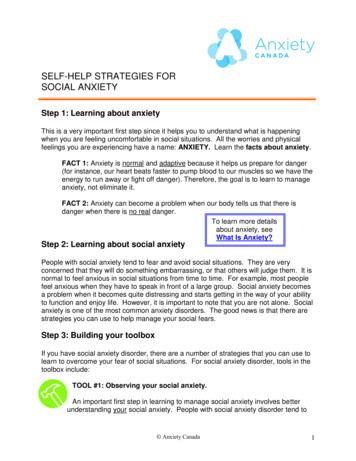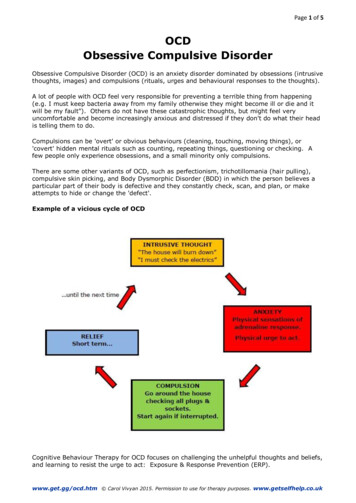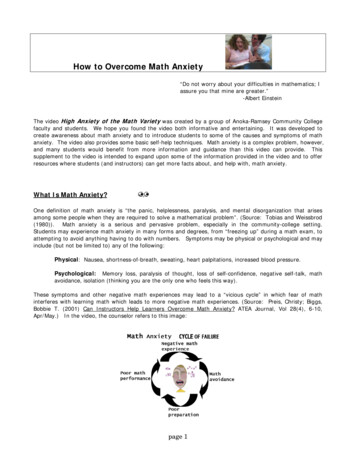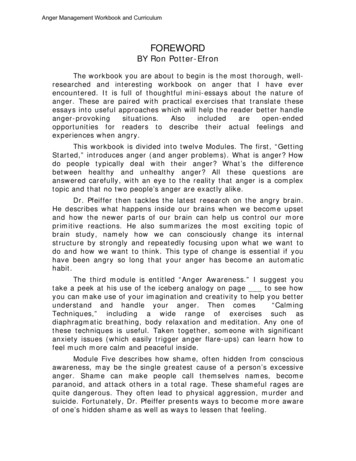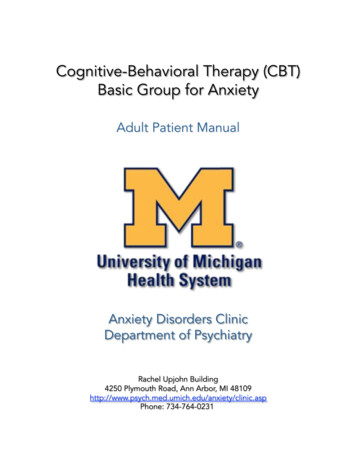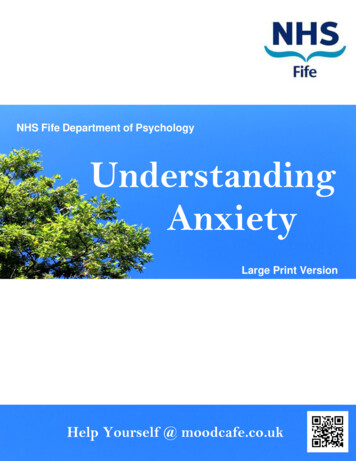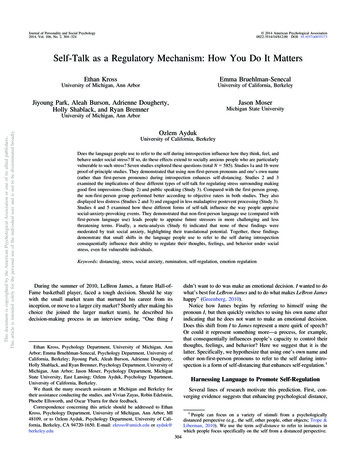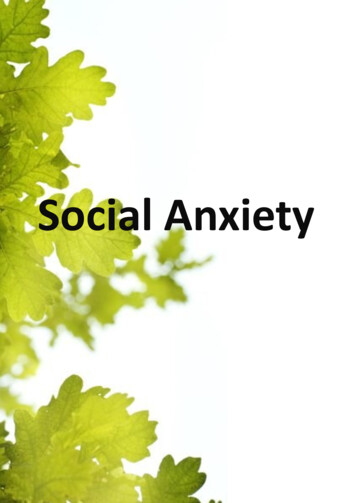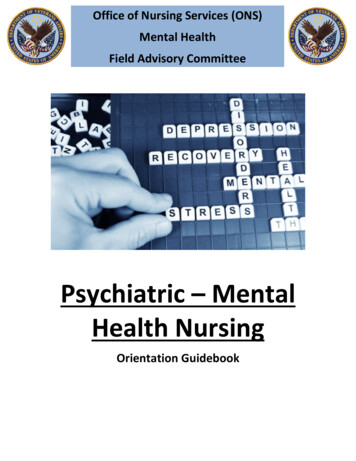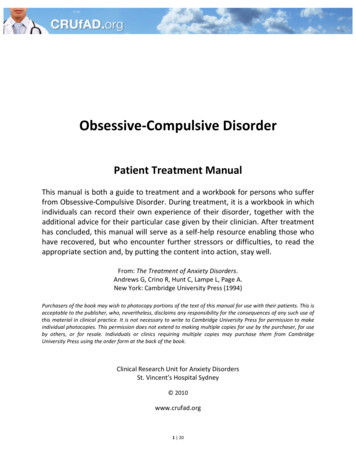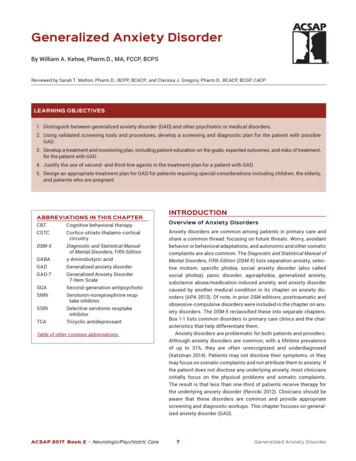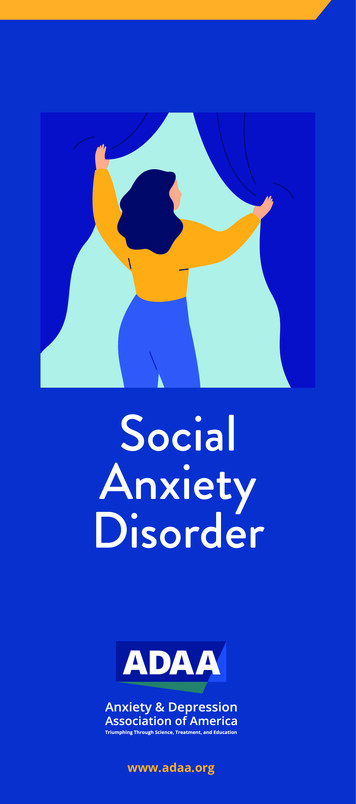
Transcription
SocialAnxietyDisorderwww.adaa.org
Social AnxietyDisorderSAD is not simply medicalized shyness. It is adisabling disorder characterized by overwhelminganxiety and excessive self-consciousness ineveryday social or performance situations.These are some common signs orsymptoms of SAD: Fear of being visibly nervous infront of others Extreme anticipatory anxiety about socialinteractions and performance situations,such as speaking to a group Fear of not knowing what to say Avoiding face-to-face interactions bydepending on technology Fear of eating in publicEveryone can relate to feeling anxious beforegiving a presentation, asking someone out on adate, or going on a job interview. Butterflies in yourstomach, sweaty palms, pounding heart—all ofthese are normal feelings in a new or intimidatingsocial situation.However, for 15 million American adults, thisanxiety causes extreme self-consciousness ineveryday social or performance situations.Their anxiety about being scrutinized andnegatively evaluated is so severe that theybecome overwhelmed with fear. This happensin what others consider nonthreatening socialinteractions—having a conversation, ordering foodin a restaurant, signing their name in public, ormaking a phone call. When anxiety occurs in thesesituations and results in significant distress, fear,impairment, or avoidance, it is referred to associal anxiety disorder (SAD).Social anxiety disorder is anunder-recognized, under-diagnosed,and under-treated disorder. Using alcohol or marijuana to function insocial situationsPeople withSAD havestrong physicalsymptomsbefore or duringsocial situations,which mayinclude blushing,sweating,trembling,nausea, heartpalpitations,chest discomfort,shortness ofbreath, dizziness,or headaches.These physicalsymptoms cancontinue for atime after thesocial situationas the anxietylevel comesdown.
Normal Anxiety vs. SADEffectsAnxiety is a normal emotional reaction to stress.Anxiety helps us get out of harm’s way and preparefor important events, and it warns us when weneed to take action.Those with SAD are at increased risk fordepression, alcohol abuse, and suicide attempts—even more so than people who have otheranxiety disorders. They may avoid anysituation in which they fear intensefeelings of anxiety and fear willarise. The disorder can disruptfamily life, reduce selfesteem, and limit workefficiency.When anxiety is persistent, excessive, seeminglyuncontrollable, overwhelming, and disabling orwhen it interferes with daily activities, you mayhave social anxiety or another anxiety disorder.People with SAD:Normal AnxietyFeeling anxious prior to makinga presentation, leading ameeting, or asking yourboss for a raise.Feeling shy andawkward whenwalking into aroom full ofstrangers.Butterfliesor jittersbefore ablinddate.Turningdowna well-earnedpromotion thatmight involvepublic speaking.Dreading your officeholiday party, experiencingintense anxiety, and leavingearly or avoiding it altogether.Refusing a dinner invitationfrom someone you’ve knownfor years for fear of blushingand embarrassing yourself.SAD May have few or no socialor romantic relationships,making them feel powerless,alone, or even ashamed. May be terrified thatthey will be negativelyevaluated or thatthey will embarrassor humiliatethemselves.This can beeconomicallydevastating becausethey have difficultycompleting school,interviewing andgetting a job, andbuilding professionalrelationships.The disordercan be selective, too.Some people mayhave an intense fear ofa single circumstancesuch as talking to asalesperson or makinga phone call, butthey can be perfectlycomfortable in othersocial settings orperforming infront of anaudience.Others may become anxious inroutine activities such as:“Do I haveSAD?” Talking to a stranger or an authority figure Participating in meetings or classes Attending parties DatingAnd some may have a performance-focusedform of SAD: giving a presentation in class or atwork or performing at a concert or sports event.However, they may be quite comfortable inother social situations.
CausesScientific research suggests that biological,genetic, and environmental factors are all riskfactors. The disorder typically begins around 13years old, but younger children can also suffer.Those who cry, cling, or fail to speak in socialsituations with other children may be suffering.Children and teens will not simply grow out ofthis disorder. If signs and symptoms persist, it’simportant to important to see a mental healthprofessional to receive a diagnosis andtreatment plan.A mental health professionalcan provide a diagnosis and anindividualized treatment plan.that actively involves people in changing the waythey perceive situations and events in their livesand helps them develop skills to better cope withanxiety. Mindfulness Training and AcceptanceCommitment Therapy (ACT) are also helpfultreatment options.Medications called selective serotonin reuptakeinhibitors (SSRIs) have also proved effective inthe treatment of SAD, and they are often usedalong with psychological therapies. Also calledantidepressants, these prescribed medicationsshould be taken under the supervision of atrained doctor.Learn more about treatment andmedication options at www.adaa.org.Children, Adolescents, and TeensChildren, adolescents, and teens with this disordermay have few or no friends. They may notparticipate in class or play at recess. Familyhistory of anxiety or depression increasesthe risk that this may not be a problem achild will grow out of.TreatmentMost people who seek treatment for SAD seesignificant improvement and enjoy a better qualityof life. You can start the conversation with yourdoctor/primary care physician and a mental healthprofessional.ADAA has resources to help you preparefor this conversation.Early diagnosis and treatment provide the besthope for preventing the onset of other relateddisorders. A variety of treatment options arescientifically proven to be effective. One evidencebased treatment is cognitive-behavioral therapy(CBT), a type of psychological therapy based firmlyon research findings. This is a short-term treatmentSAD is seen in children of all ages,but it starts more often duringthe teenage years. Rather thansaying they are anxious or afraid,children who are eight or nineyears old are more likelyto report their physicalsymptoms and wantto avoid most socialSAD does not justsituations.go away, and theconsequences oftenChildren needinclude loneliness, lowto be properlyself-esteem, reduceddiagnosedsuccess in school,and treateddepression, andearly. SAD cansubstance misuse.affect children foryears before it isdiagnosed. As childrengrow and mature, theylearn how to avoid beingthe focus of attention at school
or home; as a result, their extreme discomfort insocial situations can go unnoticed.Early intervention and treatment can be verysuccessful, and it may prevent the developmentof other disorders. It also allows children and teensto function better at school and in their social life.Some common physical symptoms ofsocially anxious children include: Stomachaches Headaches Queasiness orbutterflies in thestomach Rapid heartbeat Nausea Blushing Shortness of breath Dizziness Dry mouthTreatment for ChildrenMost young people with SAD can be successfullytreated with CBT and sometimes medication.CBT often teaches parents skills that they can useto help their child.For children with selective mutism (see next pageto learn more about this disorder), behavioraland CBT strategies are the most widely supportedpsychological treatments.Behavioral strategiesdevise a plan for achild to graduallyspeak more in difficultsituations and providepositive reinforcement.Cognitive strategiesidentify anxiousthoughts thatcontribute to thechild’s notspeaking.Medications may also be prescribed to addressthe anxiety that underlies a child’s inability tospeak in certain situations. They are most effectivewhen combined with behavioral or psychologicaltreatments.There is no single “right” treatment for socialanxiety or other disorders. What works forsomeone else may not be the best choice for youor your child. Every course of treatment shouldbe tailored to an individual’s needs. Ask yourtreatment provider to explain why a particulartype of treatment is recommended, what theother available options are, and what to do to fullyparticipate in your recovery.Learn more about effective treatments:www.adaa.org/finding-help/treatment.SAD and Other DisordersIn addition to SAD, the term “anxiety disorder”includes generalized anxiety disorder (GAD),panic disorder and panic attacks, agoraphobia,selective mutism, separation anxiety disorder,and specific phobias.How Co-occurring Disorders CanImpact SADThese other anxiety disorders co-exist with SADand can impact each other. Obsessive-compulsivedisorder (OCD) and posttraumatic stress disorder(PTSD) are closely related to anxiety disorders;anxiety is one of their primary symptoms.Some mayexperience thesedisorders alongwith depressionand relateddisorders atthe same time;depressionis a commonco-occurringdisorder.
Each disorder has specific symptoms, andtreatment for all disorders is effective.Workarounds (avoidance, self-talk, defaultresponses/scripts, turning to alcohol) are noteffective long-term and can be detrimental.Please reach out to a treatment provider for help.For more information on anxiety andco-occurring disorders, and treatmentoptions, visit: www.adaa.org.Selective MutismOften co-existing with SAD is selective mutism.People with this anxiety disorder are capable ofspeech, but they do not speak in some situationsor to some people. This disorder is usually firstnoticed when a child starts attending school,including preschool, and children with the disorderdo not necessarily improve with age.Selective mutism can contribute tochronic depression, further anxiety,limited progress in school, and othersocial and emotional problems.“Asking for help is the first step to change:If you act like everything’s all right when it’s not,how do you expect anyone to be able to helpyou? Statistics show that most people suffer insilence for around 10 years before seekinghelp with social anxiety. That makes no sensebecause this condition is treatable.”– TOBIASADAA Personal Storyof TriumphGetting HelpVisit www.adaa.org to find qualified mental healthprofessionals using the Find a Therapist directoryor the Telemental Health Provider listing.ADAA also provides resources to: Screen yourself for SAD and learnmore about treatment. Review questions to ask a mentalhealth provider. Find resources and self-help books. Read stories from those who havestruggled and triumphed.Without treatment, selective mutism interferes withschool and friendships and causes significant stressand upset within a family.For more information about selectivemutism, including treatments, visitwww.selectivemutism.org. Locate support groups in your area.We are here to help you find answers andmake good decisions for your health care.
About ADAAThe Anxiety and Depression Association ofAmerica (ADAA) works to prevent, treat, andcure anxiety disorders and depression.ADAA is an international nonprofitorganization dedicated to the prevention,treatment, and cure of anxiety, depression,OCD, PTSD, and co-occurring disordersthrough the alignment of science,treatment, and education.For information visitwww.adaa.org or contact:8701 Georgia Avenue, Suite 412Silver Spring, MD 20910information@adaa.org
social anxiety disorder (SAD). SAD is not simply medicalized shyness. It is a disabling disorder characterized by overwhelming anxiety and excessive self-consciousness in everyday social or performance situations. Social Anxiety Disorder Social anxiety disorder is an under
